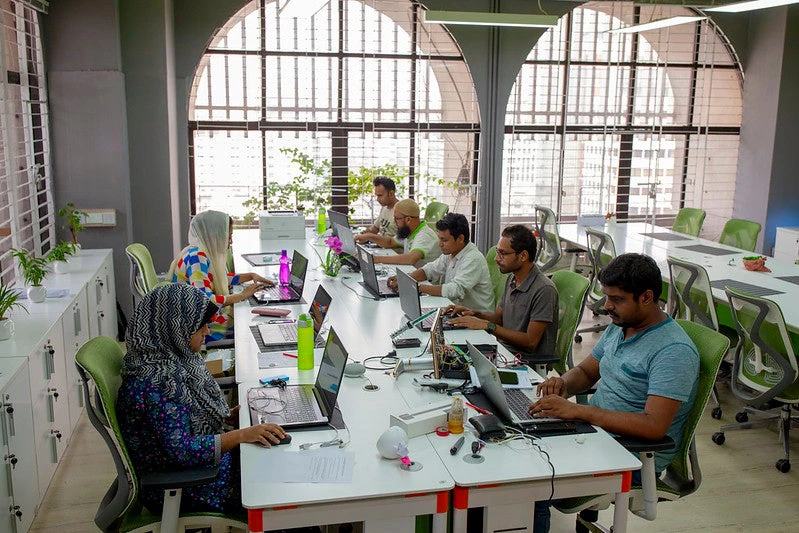 Bangladesh, Dhaka, Janata Tower software and technology park. Photo: KM/ Wolrd Bank.
Bangladesh, Dhaka, Janata Tower software and technology park. Photo: KM/ Wolrd Bank.
In the World Bank's report, "Voices of the Poor," a diverse chorus of often marginalized voices resonated globally, shedding light on the exigency of listening to the most vulnerable populations’ voices. As we progress through the digital revolution, we have the unprecedented opportunity to further amplify these voices through effective Citizen Engagement, which is crucial to improving how governments respond to citizens' needs. It relies on robust community and regional level data.
Citizen-government interactions are poised for transformation by many increasingly accessible data sources, including online language and demographic data. This journey from the foundational insights of "Voices of the Poor" to the present digital era marks a pivotal shift in how we prioritize and optimize the delivery of government services and development finance based on the needs and experiences of the most marginalized.
One of the most overlooked benefits of Artificial Intelligence (AI) in the public sector is its potential to make government websites, documents, and communication more accessible to citizens, especially in countries where people speak many languages and dialects. In India, Jugalbandi is using WhatsApp and Telegram bots powered by language models to help people in rural areas access government services in their own language. Users can ask questions via text or speech, and the chatbot responds with information in speech and text. Currently available in 10 languages, Jugalbandi covers 171 government programs, breaking language barriers for citizens.
Digitally enabled citizen engagement relies on the willingness and capacity of governments to collect, process, analyze, and respond to enormous volumes of citizen feedback. Without the public sector's capacity to effectively handle feedback data alongside data representing real phenomena, the full benefits of integrating citizen input into actionable government decision-making cannot be realized. However, emerging technologies like Large Language Models (LLMs) can bridge this gap by extracting valuable insights from feedback and triangulating it with social media and online news language data. Aggregating this information allows LLMs to provide concise summaries of the key issues raised by citizens.
Online feedback platforms like Citizen Lab and Polis are working closely with local governments, utilizing AI to analyze and utilize citizen feedback effectively.
Large Language Models can help decision-makers understand location-specific variance in citizens development priorities by analyzing volumes of solicited and unsolicited language . This process provides valuable insights for development planning and implementation.
For example, in the Philippines, the newly formed semi-autonomous Bangsamoro region's government collaborated with the Japan International Cooperation Agency (JICA) and Peloria, an AI company. By drawing on social media and online news language data in both Tagalog and English, Peloria identified critical development issues, including those specific to different communities, that traditional phone surveys had not detected.
To ensure successful training of LLMs, it is important to integrate citizen feedback data from traditional methods (such as paper surveys, phone calls, radio, and mobile phones) with digital platforms. By combining this data with government datasets, and data representing phenomena in the natural, social, and built world, AI solutions can provide actionable insights and targeted development interventions . Institutionalized avenues for citizen feedback, such as grievance mechanisms, further empower digital citizen feedback. These mechanisms enhance transparency and accountability and can be used to collect data for LLMs and machine learning (ML) models to measure and predict change in language about projects and policies.
Language data can help identify the policy-specific costs and benefits experienced by different social groups. For example, an ML-driven Cost-Benefit Analysis (CBA) tool can inform justice interventions by collecting comprehensive data, allocating resources, and measuring societal benefits, especially for marginalized groups.
Additionally, predictive ML models can identify the role of language in driving social change, such as violence or displacement, while accounting for other real phenomena. High predictive accuracy increases confidence in the significance of different factors’ relationship to change in forecast phenomena. This evidence can inform the issues development should be focused upon, both operationally and relevancy of prioritized topics for citizen engagement.
AI and ML technologies, combined with citizen feedback, can transform data into actionable insights for development finance. This approach ensures interventions are rooted in community experiences, leading to more inclusive outcomes. By bridging foundational work with modern technology, we can make inclusive and effective development a reality.





Join the Conversation